Do you have any boring grey miniatures sitting around that you’d love to paint, but painting with a brush is not your thing? Well, there’s now a new and easier way to paint models without the need for brush skills: Markers specifically designed for miniatures. I’ll compare the differences between AK’s brand-new Playmarkers and Real Color markers, classic Gundam markers, markers filled with Speedpaint from The Army Painter, and markers you can fill yourself. Painting miniatures as easily as holding a pen? I’ll show you how.
You’re probably familiar with permanent or non-permanent felt-tip markers like classic Sharpies, and in the art world, alcohol-based markers like Copics are hugely popular. However, these pens aren’t really suitable for painting miniatures. While there are paint markers for Gundam models and acrylic graffiti pens from Molotow, they haven’t really caught on in the tabletop and board game scene. But in recent months, a new trend has emerged. Companies like AK Interactive have developed a new generation of markers, specifically designed for painting miniatures from board games and tabletop games like Warhammer.
In this video, I’ll compare AK’s Real Color and Playmarkers, classic Gundam markers, markers from Deep Cut Studios filled with the popular Speedpaint by The Army Painter, as well as refillable markers you can fill with any paint you like. If painting with a brush has put you off so far, these markers might just be your gateway to add some colours to the figures of your favourite games. Apparently, all of them are even easier and faster to use than applying “one coat” paints like Contrast or Speedpaint with a brush. Let’s find out if that’s true:
Most of the products in this video were kindly provided by their respective manufacturers. Thoughts and opinions are our own.
Real Color markers by AK
First up, I’m going to test out the Real Color Markers from AK. There are 34 acrylic colours to choose from, though many of them are quite similar, focusing on earthy military tones.


They are incredibly easy to use, just take the cap off and start painting. The nib is your typical pointed felt-tip style, with a little bit of flexibility, and immediately feels natural to work with. I’ve grabbed an Ork from the new edition of HeroQuest, and as you can see in the video, no primer is needed. The paint adheres well to bare plastic. The nib allows for good control, and the finish is smooth and satin-like. Coverage is excellent, though lighter colours need multiple layers, just like regular acrylic miniature paints. I’m particularly impressed with the metallic markers; they cover in a single coat and have a lovely shiny finish with fine metallic particles. Even brush painters will be impressed by these!
Playmarkers by AK
Next up are the brand-new Playmarkers from AK. The range boasts 34 colours, with plenty of bright and vibrant hues for fantasy and sci-fi miniatures. The tip here is more brush-like, with flexible, pointed bristles. Unlike the Real Colour Markers, before you use Playmarkers for the first time, you need to soak the nib with paint by pressing the button at the end multiple times. Wipe off any excess on a towel, and you can start painting.
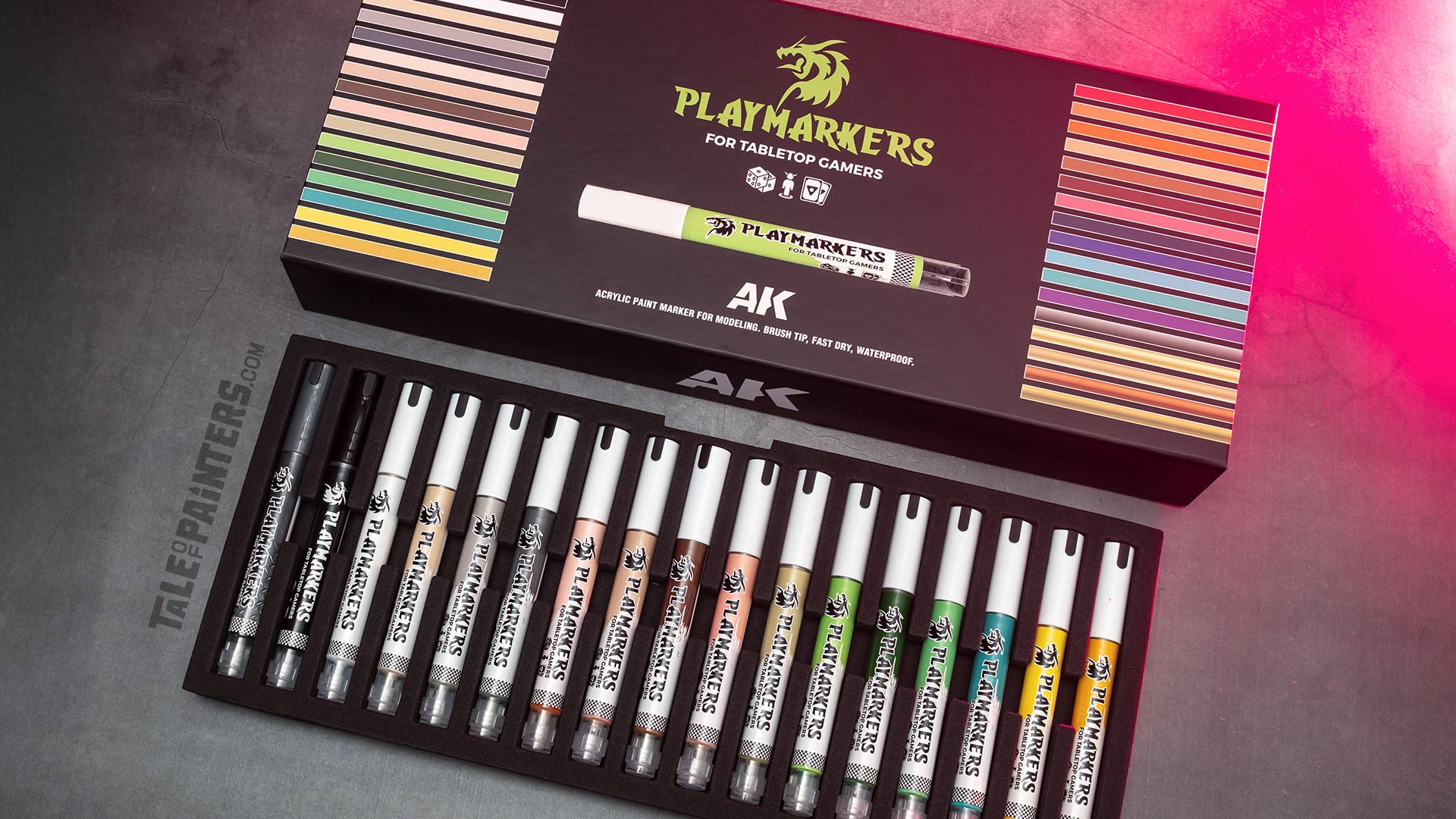

The paint is noticeably thinner and reminds me of thinned-down acrylic paint, the sort you’d use for painting minis with a brush. As you can see in the video, the paint doesn’t adhere that well to the bare plastic of the miniature, so you’ll definitely need a primer as an undercoat. I’ll finish off painting the first Ork with the Real Colour Markers and grab another one instead, which I gave a spray with black undercoat. AK does a fantastic matte black spray primer, but Chaos Black from Games Workshop or a similar product will do the job as well. Now, you might think that painting onto black is a bit counterintuitive, but one of the advantages is that you can simply leave areas that are tricky to reach black, and it’ll look as if those details are cast in shadow.
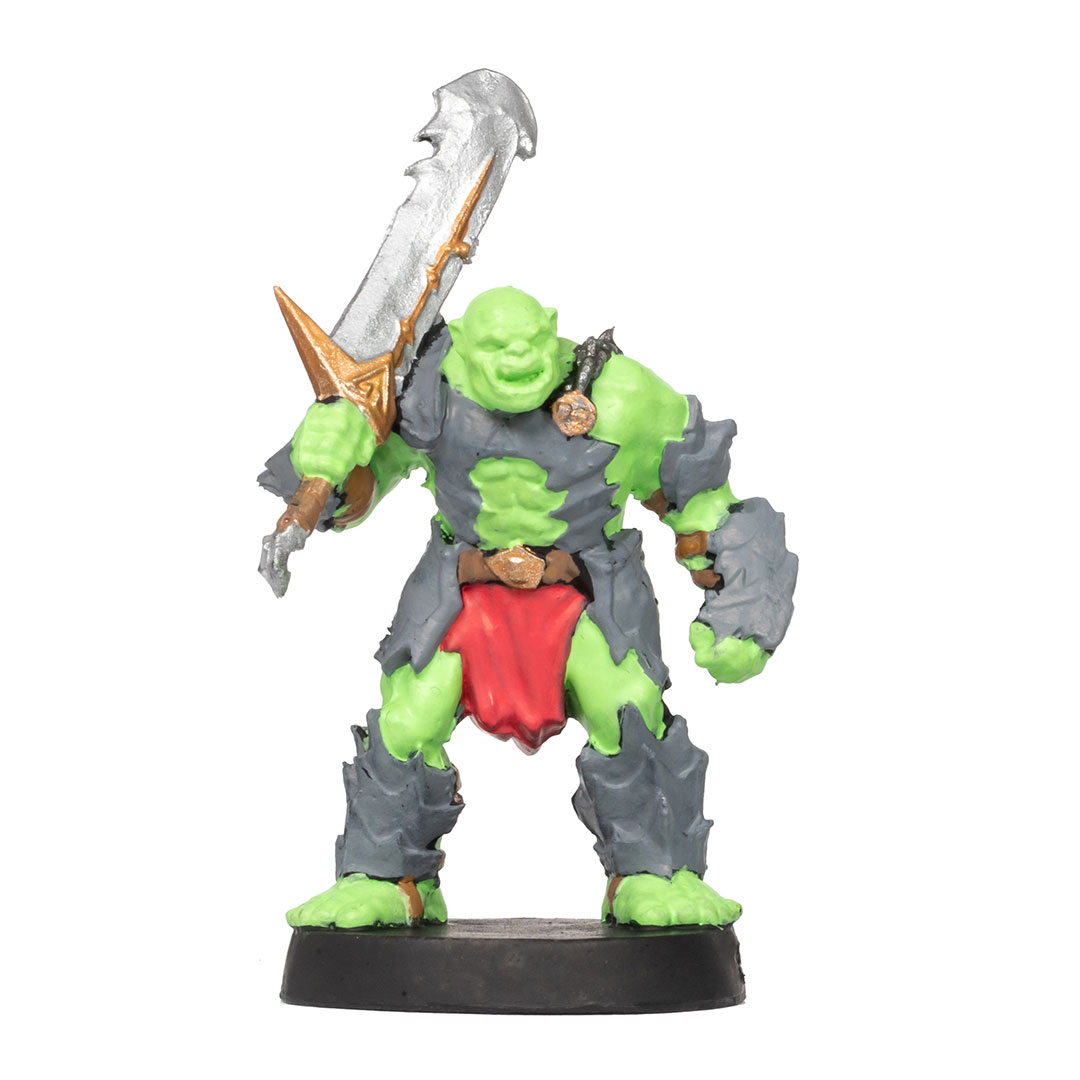

The brush-like nib of the Playmarkers means you can get to small nooks and crannies well, but you’ll need a bit more practice to get a feel for the flexible bristles. This is also because the paint is more fluid than the Real Color markers, and because of the thinner consistency brighter colours such as the green and red require quite a few coats for a perfectly even coverage. All in all, the Playmarkers feel much more like painting with a brush and less like colouring in with a pen.
Gundam markers
I’ll give you my recommendation at the end of the post, but for the sake of completeness, let’s quickly touch on Gundam Markers before we get to the Speedpaint markers in a moment. There are different types, but the classic version has a hard, square-ish tip. You need to shake them and pump paint into the nib before use. On the plus side, Gundam markers don’t require a primer and can be applied straight onto bare plastic.
But I’ll be honest – I’m not a big fan. The hard, inflexible tip makes it difficult to reach recesses, and while you can pump out paint and apply it with a brush for that, having to use a brush for this kind of defeats their purpose. Plus, the colour range is really limited and only geared towards the typical Gundam colours.
Deep Cut Studio markers filled with Army Painter Speedpaint
Okay, now onto the Speedpaint Markers. And these work completely differently. Deep Cut Studios brought these out in collaboration with The Army Painter, and you can get those in a set with the 10 or 20 most popular Speedpaint colours.
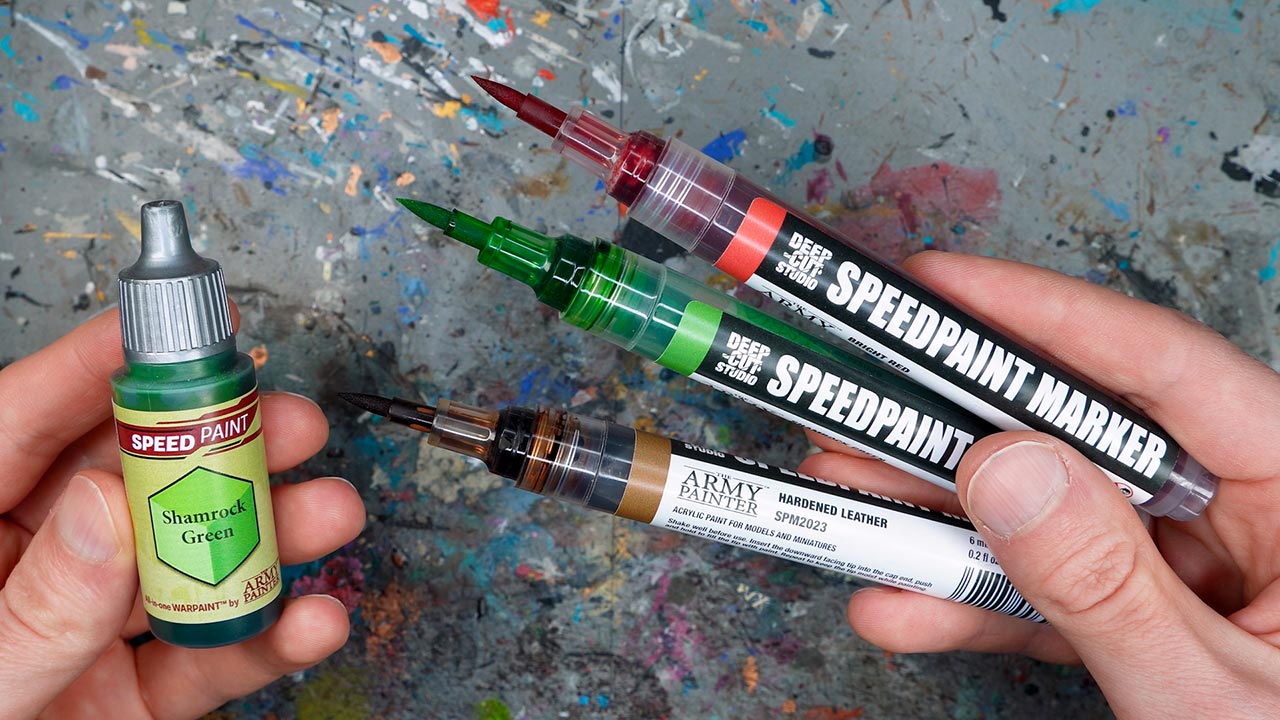

By the way, I have a hand-painted swatch of all Speedpaints you can download for free, and if you like “one coat” paints I have a very accurate hand-painted comparison chart that covers all the colours from all major brands:


This hand-painted swatch is available in my Patreon shop for a small donation (or by becoming an Autarch tier member). I also have swatches for Citadel, Vallejo Game and Model Color, Warpaints Fanatic, AK 3rd Gen and more – all cross-compatible with each other so you can compare colours across different brands. Check out my shop for details.
Okay, so here’s the difference with Speedpaint markers. They contain a transparent dye paint, designed to flow into recesses and create natural shading with just one coat. Since the paint is transparent, you’ll need a light primer so the paint can show through. I’ve primed this Heroquest Ork with White Scar spray from Games Workshop, but you can experiment with different undercoats. A bone colour like Wraithbone primer will warm up the colours, while a grey tone like Grey Seer will make them look paler and more desaturated.


The Speedpaint markers have the familiar pointed felt nibs like the Real Color Markers. Before using them, you need to pump paint into the nib, then you’re good to go. To be honest, I was initially sceptical about whether these would work as well as applying Speedpaint with a brush. But the nibs dispense just the right amount of paint to let it flow naturally into the recesses of the model. I’d say these markers make using Speedpaint even easier. Another thing I love about the Speedpaint markers is that you can replace the nibs if they wear out. Because with the other markers, it’s like this: if you damage the tip you might as well chuck the marker in the bin as it’s no longer usable for detail work.
The “one coat” drawback
However, “one coat” paints like Speedpaint, whether marker or not, have one big drawback. And that’s when it comes to correcting mistakes, which can be tricky because of the transparent nature of the paint. You can’t simply paint over mistakes, as the colour will just get darker and more patchy. For the best result you’ll need to repaint the entire area with the base colour, in this case white, before reapplying the Speedpaint evenly all over the affected area.
That said, if you’re new to miniature painting, don’t stress too much over small mistakes. You’ll improve quickly, and painted miniatures always look cooler than unpainted ones, even if they’re not perfect.
Green Stuff World refillable markers tested


Finally, there are refillable markers. I got these from Green Stuff World, but there are other brands such as Molotow, who also have a range of acrylic markers like AK. Refillable markers, like the Speedpaint markers, tend to work best with transparent “one-coat” paints like Citadel Contrast, Green Stuff World’s Dipping Inks, Speedpaint, or Vallejo Xpress Color. You can also try using artist inks, or washes like Citadel Shade paints. Regular acrylic miniature paints don’t work as well, as they would need to be heavily thinned to flow through the nib, resulting in a very watery application. The advantage of these refillable markers is of course their flexibility – you can fill them with whatever colour you like. I have to say, though, that I don’t find the tips of the Green Stuff World markers all that good; they’re too hard and inflexible.
Summary
Alright, that was quite a few different types of markers! Before I give you my personal recommendation, here’s a quick summary of the key differences. Basically, you need to differentiate between two types of markers. Firstly, markers with opaque paint, like the AK markers, and markers with transparent “one coat” paint, like Speedpaint.
Opaque markers
Opaque markers have the advantage that they cover even on dark undercoats and easily paint over mistakes. Real Color Markers and Gundam markers can even be applied directly to bare plastic. However, the colours are flat and don’t create any shading. And you sometimes need to apply several coats for a fully opaque result.
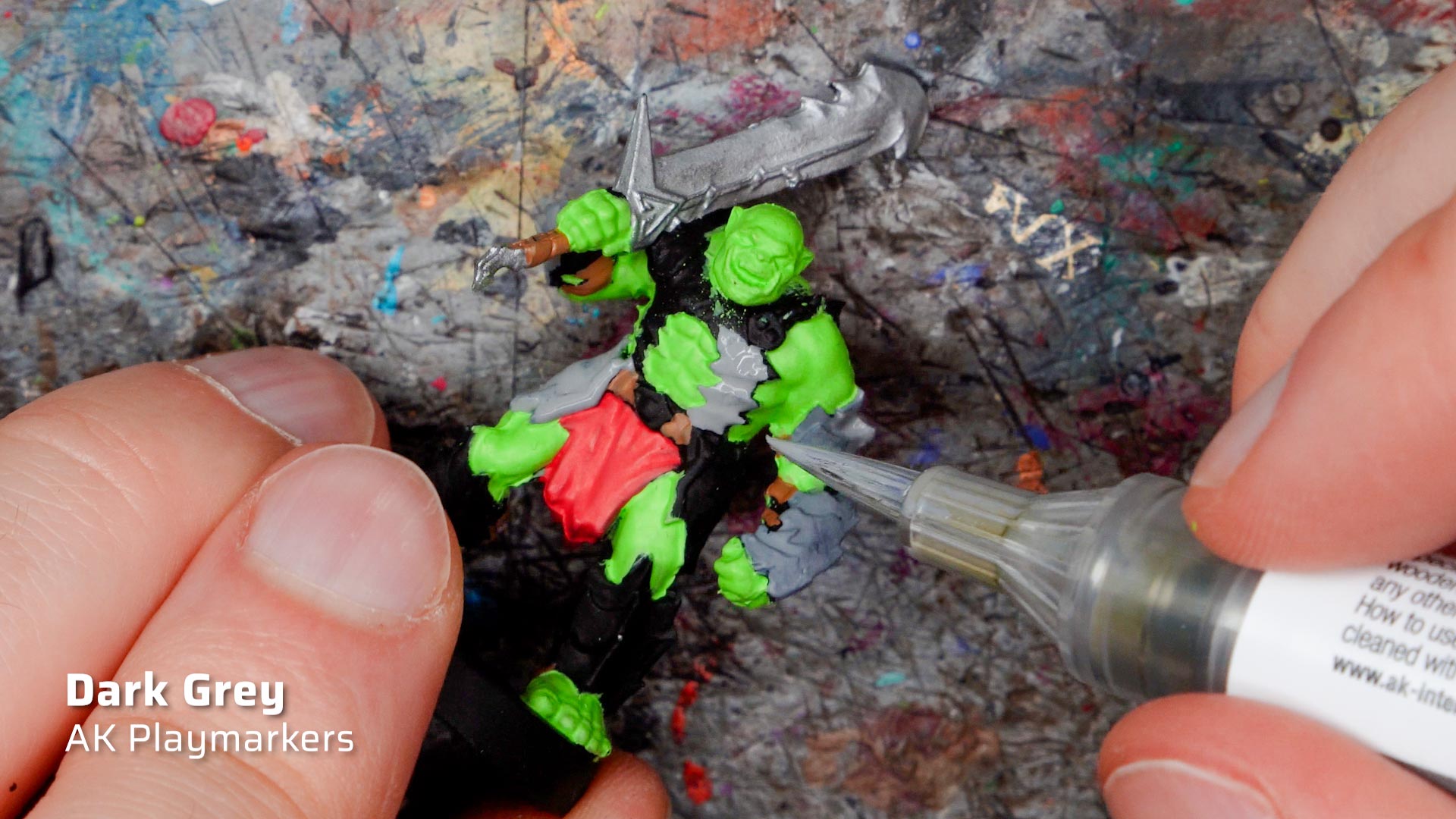

Transparent markers
Speedpaint markers, on the other hand, require a white or light primer, as the paint is transparent. With just one coat, you create a three-dimensional effect, as the colour pigments flow into the recesses naturally, thus creating shading. However, painting over mistakes is difficult, and excess paint can pool on flat areas and dry unevenly.
So which technique you prefer is a matter of personal preference. Opaque markers are better suited for larger and smooth surfaces on models, while Speedpaint shows its strengths in organic and textured areas.
My recommendation
If you want to paint your models as quickly as possible, then Speedpaint markers, as the name suggests, are the first choice. And with my hand-painted swatches it becomes as easy as painting by numbers. If you want a bit more control and to experiment, then go for opaque markers or a combination of both.
For the easiest way to get started, Real Color markers are the best – you just need to pop the cap off and you can start painting, super intuitive and no extra purchases needed. Later on, you can then progress to Playmarkers with their brush tip, or even have a go at painting with actual brushes. And if you find the result from opaque markers too flat, you can paint over them, use weathering products, or easily add extra shading with a wash.
Finishing touches
The Black Night Deepshade wash from AK is perfect for this, as it has a black-brown hue that goes with almost any colour. Thin this down with a little bit of Deepshade Medium, and apply the mix over the entire miniature. Soak up any excess wash with a clean brush and let the miniature dry. Army Painter Strong Tone wash or a mix of Nuln Oil and Agrax Earthshade work just as well. And boom, you now have a shaded model in no time and the best of both worlds.
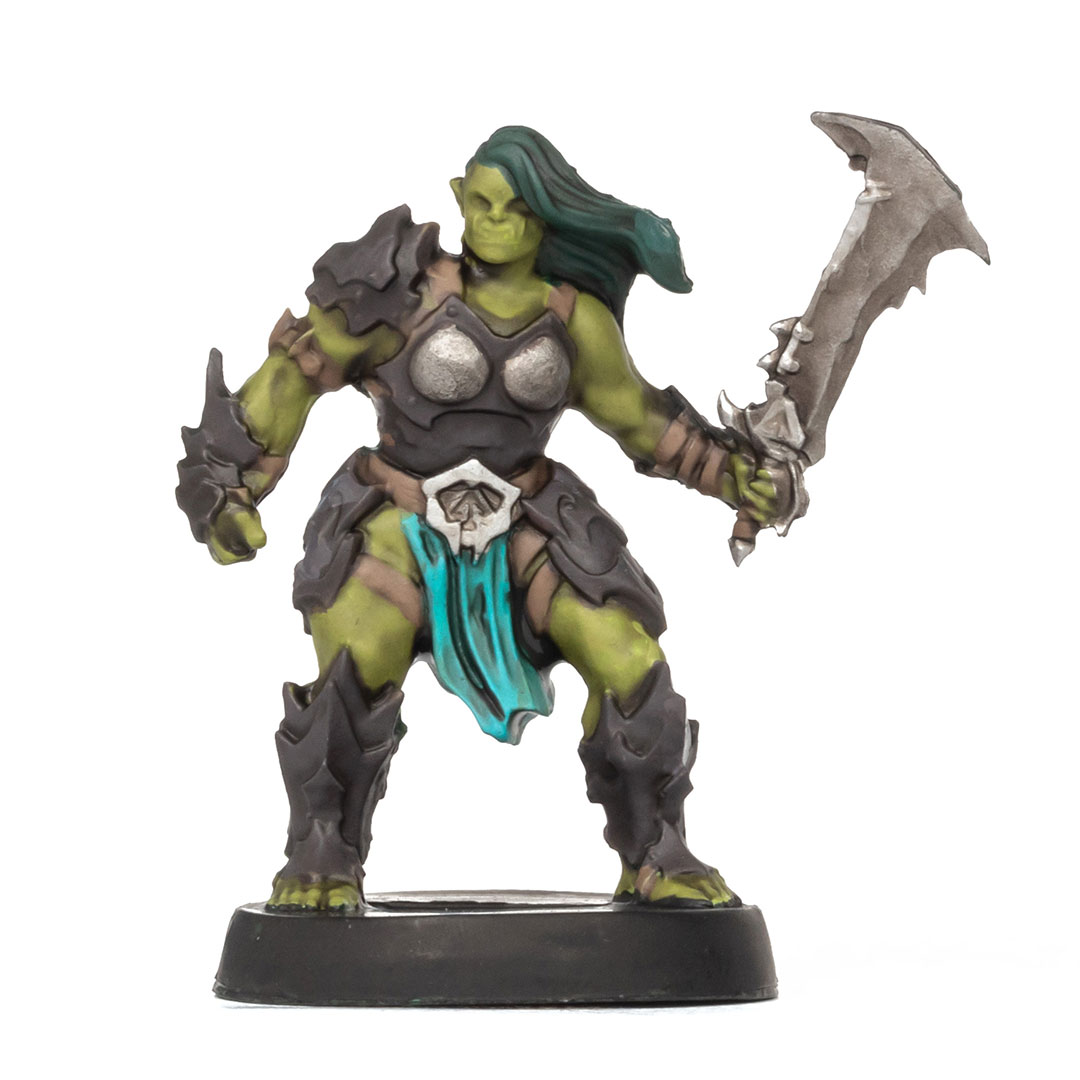

Right then, all that’s left now is to protect your painstakingly painted miniatures from your sweaty hands when you’re playing. When handling game figures, paint tends to rub off the edges quickly, and to avoid that, you’ll need a good varnish. I’ve gathered the best matt varnishes, the ones that always give me a flawless finish, here in this post:
Where to get markers
You can find the latest hobby products at our 🇬🇧/🇪🇺 partner stores Wayland Games, Element Games, and Firestorm Games, at 🇩🇪 Taschengelddieb and PK-Pro, and at 🇺🇸 Noble Knight Games with a welcome discount of up to 10 – 15% over RRP. Using our links helps to support Tale of Painters at no additional cost to you, so thank you very much for using them!
I hope you found this review helpful, feel free to leave a reaction or comment below, or post your questions here or discuss on our Discord channel.








written on the parchment was scratched out